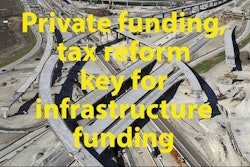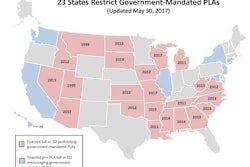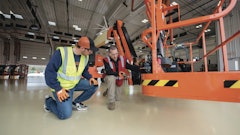
Construction employment increased in 217 out of 358 metro areas between April 2016 and April 2017, declined in 89 and stagnated in 52, according to a new Associated General Contractors of America analysis of federal employment data. Association officials noted that construction firms in many parts of the country continue to expand headcount amid strong private-sector demand for their services.
“Construction employment continues to expand in the majority of the nation’s metro areas,” said Ken Simonson, the association’s chief economist. “Many firms are adding new employees as they work to keep pace with demand for new private-sector projects.”
Riverside-San Bernardino-Ontario, Calif. (14,600 jobs, 16%) added the most construction jobs during the past year, followed by:
- Tampa-St. Petersburg-Clearwater, Fla. (8,900 jobs, 13%)
- Las Vegas-Henderson-Paradise, Nev. (8,500 jobs, 16%)
- Atlanta-Sandy Springs-Roswell, Ga. (6,800 jobs, 6%)
- San Diego-Carlsbad, Calif. (6,300 jobs, 8%)
The largest percentage gains occurred in the Lake Charles, La. metro area (29%, 5,300 jobs) metro area, followed by:
- Lewiston, Idaho-Wash. (23%; 300 jobs)
- Detroit-Dearborn-Livonia, Mich. (18%, 3,600 jobs)
- Riverside-San Bernardino-Ontario and Las Vegas-Henderson-Paradise.
The largest job losses from April 2016 to April 2017 were in Houston-The Woodlands-Sugar Land, Texas (-7,600 jobs, -3%), followed by:
- St. Louis, Mo. (-4,000 jobs, -6%)
- Chicago-Naperville-Arlington Heights, Ill. (-3,800 jobs, -3%)
- Middlesex-Monmouth-Ocean, N.J. (-3,200 jobs, -8%)
The largest percentage decreases for the year were in:
- Casper, Wyo. (-21%, -700 jobs)
- Charleston, W. Va. (-16%, -1,200 jobs)
- Gulfport-Biloxi-Pascagoula, Miss. (-12%, -1,100 jobs)
- Bay City, Mich. (-10%, - 100 jobs)
- Trenton, N.J. (-10%, -500 jobs)
Association officials cautioned that public investments in infrastructure have declined by 8.5% during the past 12 months, even as private-sector demand continues to grow. They added that deteriorating infrastructure could undermine continued economic growth as businesses are forced to pay more, and wait longer, to ship goods and services. They said an infrastructure proposal outlined by the Trump administration last week should provoke needed debate in Washington about how to pay for future public works projects.
“Private-sector demand will suffer if employers are forced to spend more to cope with congested roads, aging bridges and inefficient water systems,” said Stephen E. Sandherr, the association’s chief executive officer. “Congress needs to find a reliable and long-term way to pay for future upgrades before aging infrastructure undermines future growth prospects.”



















